Paper Menu >>
Journal Menu >>
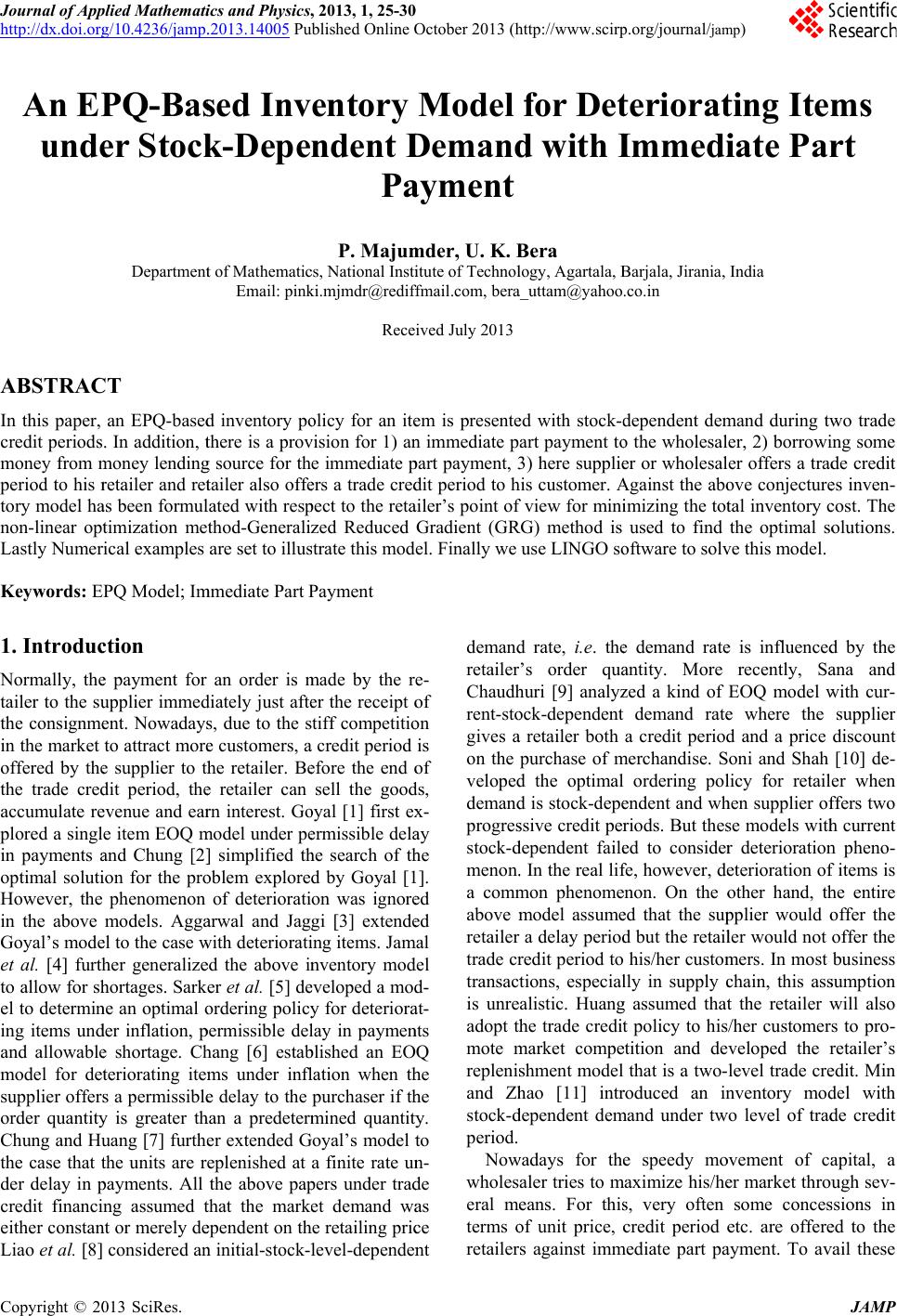 J ournal o f A pp http://dx.doi.or g Copyright © 2 0 An E P und e ABSTRA C In this paper, credit periods money from m p eriod to his r tory model h a non-linear op t Lastly Numer Keywords: E 1. Introdu c N ormally, th e tailer to the s u the consignm e in the market offered by th e the trade cre d accumulate r e p lored a singl in payments a optimal solut i However, the in the above Goyal’s mod e et al. [4] furt h to allow for s h el to determi n ing items un d and allowabl e model for de t supplier offer s order quantit y Chung and H u the case that t der delay in p credit financi either consta n Liao et al. [8] p lied Mathemat i g /10.4236/jamp . 0 13 SciRes. P Q-Ba s e r Stoc k Departmen t C T an EPQ- b ase d . In addition, t m oney lendin g r etailer and re t a s been formu l t imization me ical examples PQ Model; I m c tion e payment for u pplier imme d e nt. Nowaday s to attract mor e e supplier to t h d it period, th e e venue and ea r e item EOQ m a nd Chung [2 ] i on for the p r o phenomenon models. Agg a e l to the case w h er generaliz e h ortages. Sark n e an optimal o d er inflation, p e shortage. C h t eriorating ite m s a permissibl e y is greater t h u ang [7] furth e t he units are r p ayments. All ng assumed t n t or merely d e considered a n i cs and Ph y sics , .2013.14005 P u s ed Inv k -Depe t of Mathemati c Email: p in k d inventory p o t here is a pro v g source for th t ailer also off e l ated with res p tho d -Generali z are set to illu s m mediate Part P an order is m d iately just aft e s , due to the s e customers, a h e retailer. B e e retailer can r n interest. G o m odel under p e ] simplified t h o blem explore of deteriorati a rwal and Jag w ith deteriorat i e d the above i n er et al. [5] d e o rdering polic y p ermissible de l h ang [6] esta b m s under inf l e delay to the h an a predeter m e r extended G eplenished at the above pa p t hat the mark e e pendent on t h n initial-stock- l , 2013, 1, 25-3 0 u blished Online O entory ndent D P a P. Maju m c s, National Inst i k i.mjmdr@redi ff Rece o licy for an it e v ision for 1) a n e immediate p e rs a trade cre d p ect to the ret a z ed Reduced s trate this mod P aymen t m ade by the r e r the receipt o s tiff competiti o a credit period e fore the en d o sell the goo d o yal [1] first e x e rmissible del a h e search of t h d by Goyal [ 1 on was ignor e g i [3] extend e i ng items. Ja m n ventory mo d e veloped a mo d y for deterior a l ay in payme n b lished an EO l ation when t h purchaser if t h m ined quantit y G oyal’s model t a finite rate u n p ers under tra d e t demand w a h e retailing pri c l evel-depende n 0 O ctobe r 2013 ( h Model D eman d a yment m der, U. K. B i tute of Techno l ff mail.com, ber a ive d July 2013 e m is present e n immediate p p art paymen t , 3 d it period to h a iler’s point o f Gradient (G R el. Finally we e- o f o n is o f d s, x - a y h e 1 ]. e d e d m al d el d - a t- n ts Q h e h e y . t o n - d e a s c e nt deman d retailer Chaud h rent-st o gives a on the velope d deman d p rogre s stock- d menon . a com m above m retailer trade c r transac t is unre adopt t h mote m repleni s and Z h stock- d period. N o w wholes eral m e terms o retailer h ttp://www.scir p for De t d with I B era l ogy, Agartala, B a _uttam@yahoo e d with stoc k - d art payment t o 3 ) here suppli e h is customer. A f view for min i R G) method is use LINGO s o d rate, i.e. th e ’s order qu a h uri [9] analy z o c k -dependent a retailer both purchase of m d the optimal d is stoc k -dep e s sive credit pe r d ependent fail e . In the real li f m on phenom e m odel assum e a delay perio d r edit period to t ions, especia l alistic. Huan g h e trade credi t m arket comp e s hment model h ao [11] int r d ependent de m w adays for th e aler tries to m e ans. For thi s o f unit price, c s against im m p .org/journal/ ja m t eriora t I mmed i B arjala, Jirania, .co.in d ependent de m o the wholesal e r or wholesal A gainst the ab o i mizing the to t used to find o ftware to sol v e demand rat e a ntity. More z ed a kind of demand rat e a credit perio d m erchandise. S ordering po l e ndent and w h r iods. But the s e d to conside r f e, however, d e e non. On the o e d that the su p d but the retai l his/her custo m l ly in supply c g assumed tha t t policy to his e tition and de tha t is a two- r oduce d an i n m and under t w e speedy m o m aximize his/h e s , very often c redit period e m ediate part p a m p ) t ing Ite m i ate Pa r India m and during t w e r , 2) borrow i er offers a tra d o ve conjectur e t al inventory c the optimal s o v e this model. e is influence d recently, S a EOQ model w e where the d and a price oni and Shah l icy for retail h en supplier o f s e models wit h r deterioratio n e terioration o f o ther hand, t h p plier would o l er would not m ers. In most c hain, this as s t the retailer w /her customer veloped the r level trade cr e n ventory mo d w o level of tra d o vement of c a e r market thro u some conce s e tc. are offer e a yment. To a v JAMP m s r t w o trade i ng some d e credit e s inven- c ost. The o lutions. d by the a na and w ith cur- supplier discount [10] de- er when f fers two h current n pheno- f items is h e entire o ffer the offer the business s umption w ill also s to p r o- r etailer’s e dit. Min d el with d e credit a pital, a u gh sev- s sions in e d to the v ail these 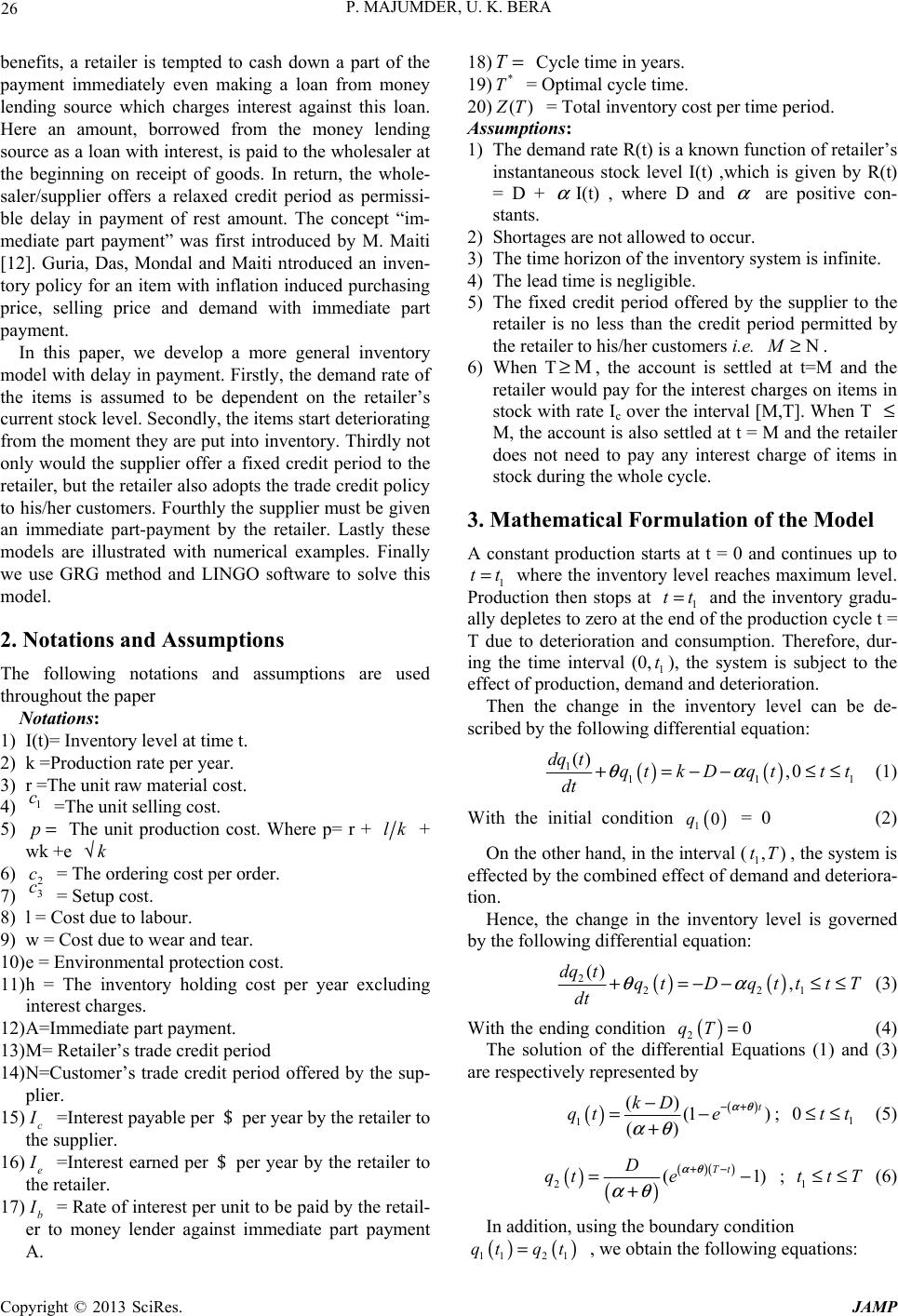 P. MAJUMDER, U. K. BERA Copyright © 2013 SciRes. JAMP 26 benefits, a retailer is tempted to cash down a part of the payment immediately even making a loan from money lending source which charges interest against this loan. Here an amount, borrowed from the money lending source as a loan with interest, is paid to the wholesaler at the beginning on receipt of goods. In return, the whole- saler/supplier offers a relaxed credit period as permissi- ble delay in payment of rest amount. The concept “im- mediate part payment” was first introduced by M. Maiti [12]. Guria, Das, Mondal and Maiti ntroduced an inven- tory policy for an item with inflation induced purchasing price, selling price and demand with immediate part payment. In this paper, we develop a more general inventory model with delay in payment. Firstly, the demand rate of the items is assumed to be dependent on the retailer’s current stock level. Secondly, the items start deteriorating from the moment they are put into inventory. Thirdly not only would the supplier offer a fixed credit period to the retailer, but the retailer also adopts the trade credit policy to his/her customers. Fourthly the supplier must be given an immediate part-payment by the retailer. Lastly these models are illustrated with numerical examples. Finally we use GRG method and LINGO software to solve this model. 2. Notations and Assumptions The following notations and assumptions are used throughout the paper Notations: 1) I(t)= Inventory level at time t. 2) k =Production rate per year. 3) r =The unit raw material cost. 4) 1 c =The unit selling cost. 5) p= The unit production cost. Where p= r + lk + wk +e k√ 6) 2 c = The ordering cost per order. 7) 3 c = Setup cost. 8) l = Cost due to labour. 9) w = Cost due to wear and tear. 10) e = Environmental protection cost. 11) h = The inventory holding cost per year excluding interest charges. 12) A=Immediate part payment. 13) M= Retailer’s trade credit period 14) N=Customer’s trade credit period offered by the sup- plier. 15) c I =Interest payable per $ per year by the retailer to the supplier. 16) e I =Interest earned per $ per year by the retailer to the retailer. 17) b I = Rate of interest per unit to be paid by the retail- er to money lender against immediate part payment A. 18) T= Cycle time in years. 19) * T = Optimal cycle time. 20) () Z T = Total inventory cost per time period. Assumptions: 1) The demand rate R(t) is a known function of retailer’s instantaneous stock level I(t) ,which is given by R(t) = D + α I(t) , where D and α are positive con- stants. 2) Shortages are not allowed to occur. 3) The time horizon of the inventory system is infinite. 4) The lead time is negligible. 5) The fixed credit period offered by the supplier to the retailer is no less than the credit period permitted by the retailer to his/her customers i.e. NM≥. 6) When TM≥, the account is settled at t=M and the retailer would pay for the interest charges on items in stock with rate Ic over the interval [M,T]. When T ≤ M, the account is also settled at t = M and the retailer does not need to pay any interest charge of items in stock during the whole cycle. 3. Mathematical Formulation of the Model A constant production starts at t = 0 and continues up to 1 tt= where the inventory level reaches maximum level. Production then stops at 1 tt= and the inventory gradu- ally depletes to zero at the end of the production cycle t = T due to deterioration and consumption. Therefore, dur- ing the time interval (0, 1 t), the system is subject to the effect of production, demand and deterioration. Then the change in the inventory level can be de- scribed by the following differential equation: () () 1 111 () ,0 dq tqtk Dqttt dt θα +=−− ≤≤ (1) With the initial condition () 10q = 0 (2) On the other hand, in the interval (1,)tT, the system is effected by the combined effect of demand and deteriora- tion. Hence, the change in the inventory level is governed by the following differential equation: () () 2 221 () , dq tqtDqtt tT dt θα +=−− ≤≤ (3) With the ending condition () 20qT= (4) The solution of the differential Equations (1) and (3) are respectively represented by () () 1 () (1 ) () t kD qt e αθ αθ −+ − =− +; 1 0tt≤≤ (5) () () ()() 2(1) Tt D qt e αθ αθ +− =− + ; 1 ttT≤≤ (6) In addition, using the boundary condition () () 11 21 qt qt= , we obtain the following equations: 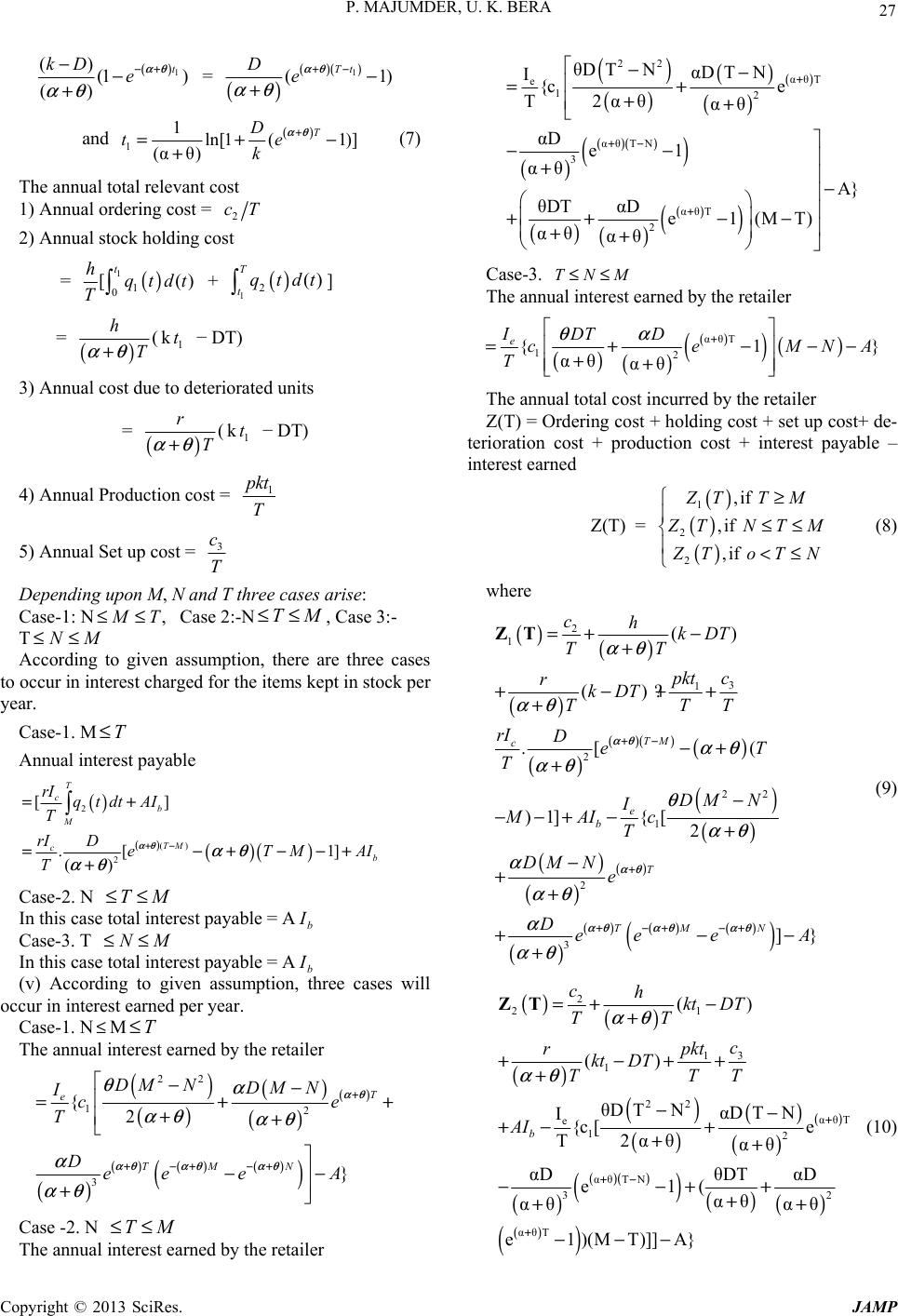 P. MAJUMDER, U. K. BERA Copyright © 2013 SciRes. JAMP 27 () 1 () (1 ) () t kD e αθ αθ −+ −− + = () ()() 1 (1) Tt De αθ αθ +− − + and () 1 1ln[1 (1)] (αθ) T D te k αθ + =+− + (7) The annual total relevant cost 1) Annual ordering cost = 2 cT 2) Annual stock holding cost = () 1 1 0 [() t hqtdt T + () 12() T tqtdt ] = () ( h T αθ +k1 t − DT) 3) Annual cost due to deteriorated units = () ( r T αθ +k1 t − DT) 4) Annual Production cost = 1 pkt T 5) Annual Set up cost = 3 c T Depending upon M , N and T three cases arise: Case-1: N, M T≤≤ Case 2:-NTM≤≤ , Case 3:- TNM≤≤ According to given assumption, there are three cases to occur in interest charged for the items kept in stock per year. Case-1. MT≤ Annual interest payable () () ()( ) 2 () 2 ] .[ 1] () [ T cb M TM cb rI qtdt AI T rID eTMAI T αθ αθ αθ +− =+ =−+−−+ + Case-2. N TM≤≤ In this case total interest payable = Ab I Case-3. T NM≤≤ In this case total interest payable = Ab I (v) According to given assumption, three cases will occur in interest earned per year. Case-1. N≤MT≤ The annual interest earned by the retailer () () () () () () () ()() () 22 12 3 {2 } T e TM N DM NDM N Ice T Dee eA αθ αθ αθαθ θα αθ αθ α αθ + +−+−+ −− =++ + + −− + Case -2. N TM≤≤ The annual interest earned by the retailer () () () () () () ()( ) () () () () () 22 αθT e 12 αθ TN 3 αθT 2 θDTNαDT N I{c e T2αθ αθ αDe1 αθ A} θDT αDe1(MT) αθ αθ + +− + −− =+ ++ −− +− + +−− + + Case-3. TNM≤≤ The annual interest earned by the retailer () () () () () αθT 12 {1} αθ αθ e IDT D ceMNA T θα + =+ −−− ++ The annual total cost incurred by the retailer Z(T) = Ordering cost + holding cost + set up cost+ de- terioration cost + production cost + interest payable – interest earned Z(T) = () () () 1 2 2 ,if ,if ,if ZTTM Z TNTM Z ToTN ≥ ≤≤ <≤ (8) where () () () () ()( ) () () () () () () () () ()() () 2 1 3 1 2 22 1 2 3 ( ( ? .[ ( )1][ 2 ) ] ) { } TM c e b T TM N chkDT TT c pkt rkDT TTT rI DeT T DM N I MAIc T DM Ne Dee eA αθ αθ αθ αθαθ αθ αθ αθ αθ θ αθ α αθ α αθ +− + +−+−+ =+ − + +−++ + −+ + − −−+ −+ − ++ +−− + ZT (9) () () () () () () () () () ()( ) () () () () () 2 21 3 1 1 22 αθT e 12 αθ TN 32 αθT ( ( θDT NαDT N I{c e T2αθ αθ αDθDT αD e1( αθ αθ αθ e1 )(MT)]] ) } ) A [ b chkt DT TT c pkt rkt DT TTT AI αθ αθ + +− + =+ − + +−++ + −− +− + ++ −−++ + ++ −−− ZT (10) 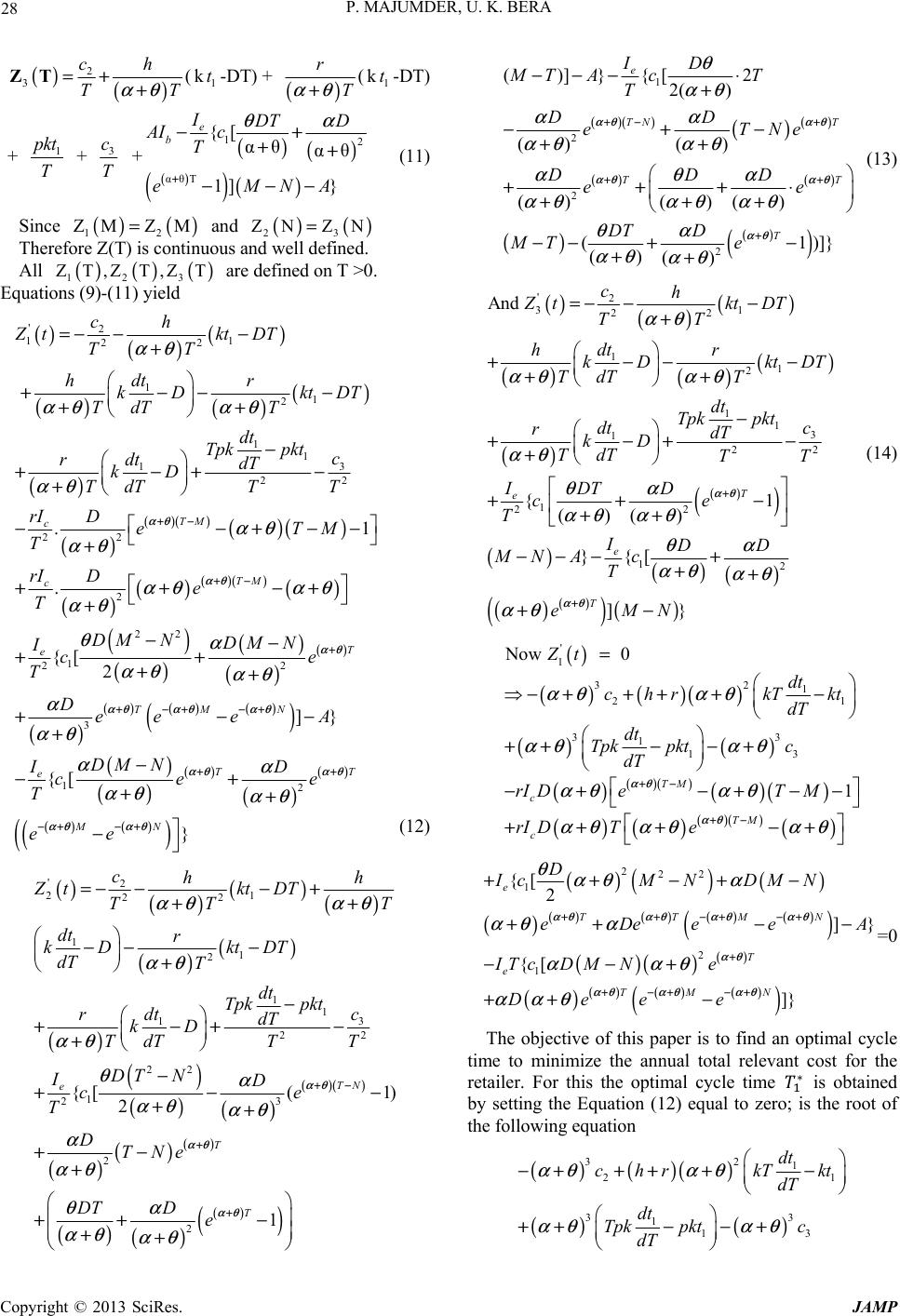 P. MAJUMDER, U. K. BERA Copyright © 2013 SciRes. JAMP 28 () () 2 3( ch TT αθ =++ ZT k1 t-DT) + () ( r T αθ +k1 t-DT) + 1 pkt T + 3 c T + () () () () () 12 αθT [{αθ αθ 1] } e b IDT D AI c T eMNA θα + −+ ++ −−− (11) Since () () 12 ZMZ M= and () () 23 ZN ZN= Therefore Z(T) is continuous and well defined. All () () () 123 ZT,Z T,ZT are defined on T >0. Equations (9)-(11) yield () () () () () () () () ()( ) ()() () () ()() () () () () () () () '2 11 22 1 1 2 1 13 1 22 22 2 22 1 22 3 . [ 1 . {2 TM c TM c T e ch Ztkt DT TT dt hr kD ktDT TdT T dt Tpkpkt c dt rdT kD TdT TT rI DeTM T rI De T DM NDM N Ice T D αθ αθ αθ αθ αθ αθ αθ αθ αθ αθ αθ αθ θα αθ αθ α αθ +− +− + =− −− + +−−− ++ − +−+− + −−+−− + ++−+ + −− ++ ++ ++ () ()() () () () () () () () () () ( 12 ]} {[ } TM N TT e MN ee eA DMN ID ce e T ee αθ αθαθ αθ αθ αθ αθ αα αθ αθ +−+ −+ ++ −+ −+ −− − −+ ++ − (12) () () () () () () () () () () ()() () () () () () () () '2 21 22 1 1 2 1 13 1 22 22 1 23 2 2 {(1) 2 1 [TN e T T chh ZtktDTT TT dt r kD ktDT dT T dt Tpkpkt c dt rdT kD TdT TT DT N ID ce T DTNe DTD e αθ αθ αθ αθ αθ αθ αθ θα αθ αθ α αθ θα αθ αθ +− + + =−−−++ + −− − + − +−+− + − +−− ++ +− + ++ − ++ ()( ) () () () () () () () 1 2 2 2 ()]}{[2 2( ) () () ()() () (1 )]} () () e TN T TT T ID MT AcT T DD eTNe DDD ee DT D MT e αθ αθ αθ αθ αθ θ αθ αα αθ αθ αθα αθ αθ αθ θα αθ αθ +− + ++ + −−− ⋅ + −+− + + +++⋅ ++ + −− +− ++ (13) () () () () () () () () () () () () () () () () '2 31 22 1 1 2 1 13 1 22 1 22 12 And {1 () () }{ ]} [ T e e T ch Ztkt DT TT dt hr kD ktDT TdT T dt Tpkpkt c dt rdT kD TdT TT IDT D ce T IDD MN Ac T eMN αθ αθ αθ αθ αθ αθ θα αθ αθ θα αθ αθ αθ + + −− − + +−−− ++ − +−+− + ++ − ++ −−− + ++ +− = (14) () ()()() () () () ()( ) ()() ()() ()() () ' 1 32 1 21 33 1 13 Now 0 1 TM c TM c Zt dt chrkT kt dT dt Tpk pktc dT rI DeTM rI DTe αθ αθ αθ αθ αθ αθ αθ αθ αθ αθαθ +− +− = −+++ +− ++− −+ −+ −+−− ++ +−+ () () () () ()() ()() () ()() () () () ()() () 222 1 2 1 2 {[ ]} { } [ ] e TTMN T e TM N D IcMNDM N eDeee A IT cDMNe Dee e αθαθαθαθ αθ αθ αθαθ θαθ α αθ α ααθ ααθ ++ −+−+ + +−+−+ ++−+− ++ −− −−+ ++ − =0 The objective of this paper is to find an optimal cycle time to minimize the annual total relevant cost for the retailer. For this the optimal cycle time ∗ is obtained by setting the Equation (12) equal to zero; is the root of the following equation ()()() () () 32 1 21 33 1 13 dt chrkT kt dT dt Tpk pktc dT αθαθ αθ αθ −+++ +− ++−−+  P. MAJUMDER, U. K. BERA Copyright © 2013 SciRes. JAMP 29 () ()( ) ()() ()() ()() () 1 TM c TM c rI DeTM rI DTe αθ αθ αθ αθ αθ αθαθ +− +− −+ −+−− ++ +−+ () () () () ()() ()() () ()() () () () ()() () 222 1 2 1 2 {[ ]} { 0 [ ] e TTMN T e TM N D IcMNDM N eDeee A IT cDMNe Dee e αθαθ αθαθ αθ αθ αθαθ θαθ α αθ α ααθ ααθ ++ −+−+ + +−+ −+ ++−+− ++ −− −−+ ++ − = (15) () Equation15is the optimality condition of (9) Now ' 2 Z (t) = 0 ()()() () () () () () () ()()( ) () () () () () () () () ()( ) ()() () () () () 32 1 21 33 1 13 222 1 2 2 1 2 2 {[ 2 1 1( )] }{[ e TTN T TN e TT dt chrkT kt dT dt Tpkpktc dT D IcTNDT N eDe DTDeM T AITcDT De DTNeDe D αθ αθ αθ αθ αθ αθ αθ αθ αθ αθ θαθα αθ α θαθααθ θα θααθ ααθ ααθ θαθ ++− + +− ++ −+++ +− ++− −+ ++−+− +− − ++++ −− −−+ −+ ++−+ + ++ () () () () () () () () () 2 21]} 0 T T DeMT DT De αθ αθ ααθ αθθααθ + + ++− −++ +− = (16) () Equation16is the optimality conditionof (10) Again ' 3 Z (t) = 0 ()()() () () () () () () () () () () () 32 1 21 33 1 13 2 1 22 1 1{[ ] } { }0 T e T e dt chrkT kt dT dt Tpk pktc dT IcDT De MN A IT cDDe MN αθ αθ αθ αθ αθ αθ θα θααθ θαθ ααθ + + −+++ +− ++− −+ ++++ − −− −+++ −= (17) () Equation17is the optimality conditionof (11) 4. Numerical Examples To illustrate the results of the proposed model we solve the following numerical examples Example 1. When1150 /,c Rsunit= 2100 /cRsorder=, 350cRs=, M = 0.5 year, N = 0.01 year, D = 1500 units per year , k = 2000 units/year, A = Rs 700 , h = Rs 15/unit, r = Rs 4/unit, l = Rs200, w = Rs 0.0005, e = Rs 0.1, 0.12 e I=, 0.17 c I=, 0.15 b I=, 0.2,0.2 αθ == then the optimal value of T is * 15.231635T=and * 11 Z ()30310.78T= Example 2. When1150 /,c Rsunit= 2100 /cRsorder=, 350cRs=, M = 2.5 year, N = 0.01 year, D = 1000 units per year , k = 2500 units/year, A = Rs 2000 , h = Rs 10/unit, r = Rs 4/unit, l = Rs200, w = Rs 0.05, e = Rs 0.1, 0.12 e I=, 0.17 c I=, 0.15 b I=, 0.1,0.1 αθ == then the optimal value of T is * 21.068099T= and * 22 Z ()165639.8T= Example 3. When 1136 /,c Rsunit=2100 /cRs order=,330cRs=, M=2.1 year, N =1.07 year, D = 2000 units per year , k = 2500 units/year, A = Rs 2800 , h = Rs 10/unit, r = Rs 4/unit, l = Rs100 , w = Rs 0.05, e = Rs 0.1, 0.15 e I=, 0.20 c I=, 0.12 b I= , 0.1,0.1 αθ == then the op- timal value of T is * 30.9165449T=and * 33 Z ()79741.83T= 5. Conclusions In this paper, we develop an EPQ model for deteriorating items under permissible delay in payments. The primary difference of this paper as compared to previous studies is that we introduced a generalized inventory model by relaxing the traditional EOQ model in the following seven ways: 1) the demand of the items is dependent on the retailer’s current stock level, 2) the retailer’s selling price per unit is higher than its purchase unit cost, 3) many items deteriorate continuously such as fruits and vegetables, 4) the supplier not only would offer a fixed credit period to the retailer, but the retailer also adopts the trade credit policy to promote market competition, 5) supplier must be given an immediate part payment by the retailer after receipt of goods, 6) minimizing inventory cost is used as the objective to find the optimal reple- nishment policy. Three numerical examples are set to illustrate this model. For the first example, * 1 T is the optimal value of T, for second and third, the optimal value of T is * 2 T and * 3 T respectively. This presented model can be further extended to some more practical situations, such as we could allow for shortages. Also quantity discounts, time value of money and inflation etc. may be added in this paper. REFERENCES [1] S. K. Goyal, “Economic Order Quantity under Conditions of Permissible Delay in Payments,” The Journal of the 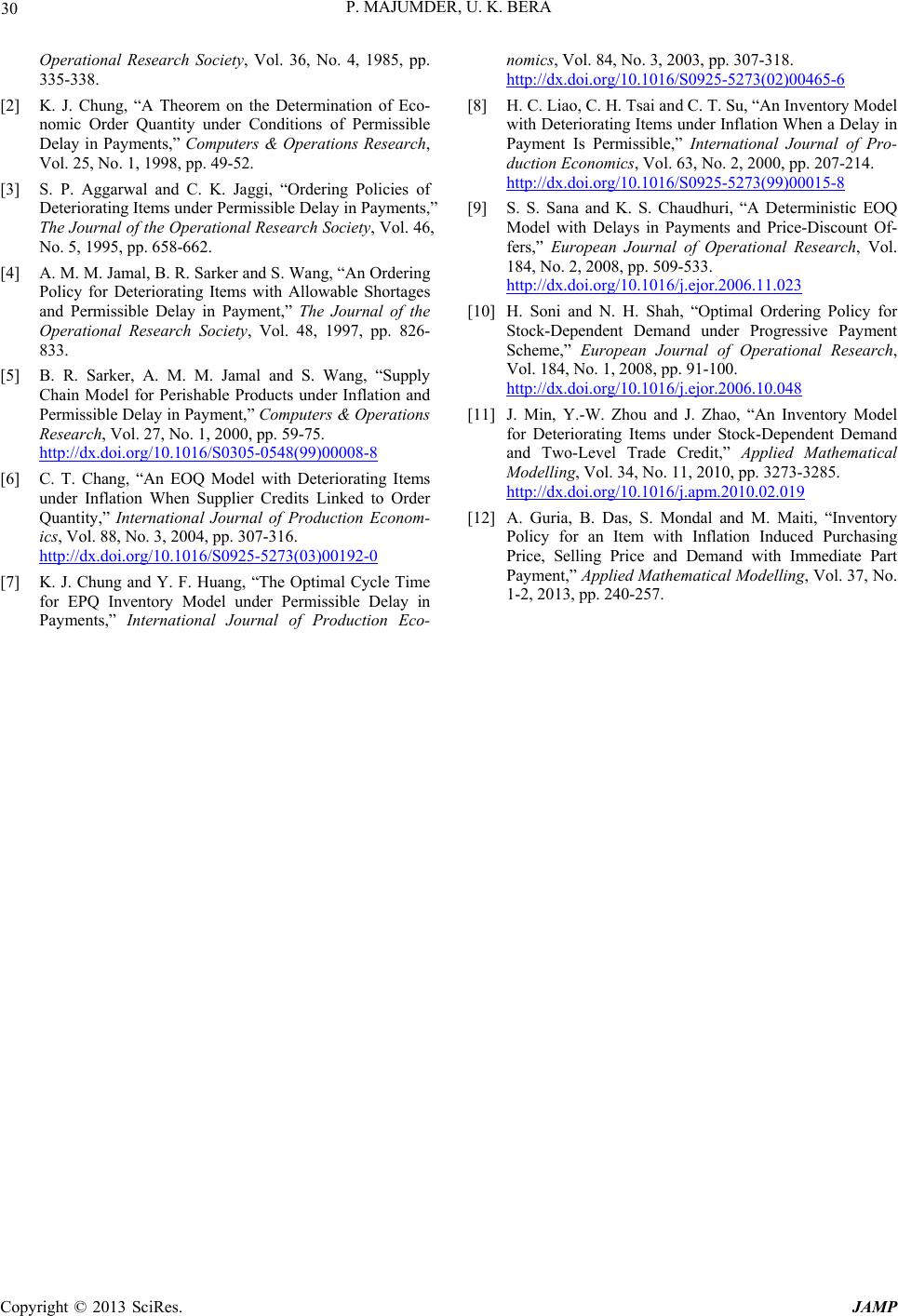 P. MAJUMDER, U. K. BERA Copyright © 2013 SciRes. JAMP 30 Operational Research Society, Vol. 36, No. 4, 1985, pp. 335-338. [2] K. J. Chung, “A Theorem on the Determination of Eco- nomic Order Quantity under Conditions of Permissible Delay in Payments,” Computers & Operations Research, Vol. 25, No. 1, 1998, pp. 49-52. [3] S. P. Aggarwal and C. K. Jaggi, “Ordering Policies of Deteriorating Items under Permissible Delay in Payments,” The Journal of the Operational Research Society, Vol. 46, No. 5, 1995, pp. 658-662. [4] A. M. M. Jamal, B. R. Sarker and S. Wang, “An Ordering Policy for Deteriorating Items with Allowable Shortages and Permissible Delay in Payment,” The Journal of the Operational Research Society, Vol. 48, 1997, pp. 826- 833. [5] B. R. Sarker, A. M. M. Jamal and S. Wang, “Supply Chain Model for Perishable Products under Inflation and Permissible Delay in Payment,” Computers & Operations Research, Vol. 27, No. 1, 2000, pp. 59-75. http://dx.doi.org/10.1016/S0305-0548(99)00008-8 [6] C. T. Chang, “An EOQ Model with Deteriorating Items under Inflation When Supplier Credits Linked to Order Quantity,” International Journal of Production Econom- ics, Vol. 88, No. 3, 2004, pp. 307-316. http://dx.doi.org/10.1016/S0925-5273(03)00192-0 [7] K. J. Chung and Y. F. Huang, “The Optimal Cycle Time for EPQ Inventory Model under Permissible Delay in Payments,” International Journal of Production Eco- nomics, Vol. 84, No. 3, 2003, pp. 307-318. http://dx.doi.org/10.1016/S0925-5273(02)00465-6 [8] H. C. Liao, C. H. Tsai and C. T. Su, “An Inventory Model with Deteriorating Items under Inflation When a Delay in Payment Is Permissible,” International Journal of Pro- duction Economics, Vol. 63, No. 2, 2000, pp. 207-214. http://dx.doi.org/10.1016/S0925-5273(99)00015-8 [9] S. S. Sana and K. S. Chaudhuri, “A Deterministic EOQ Model with Delays in Payments and Price-Discount Of- fers,” European Journal of Operational Research, Vol. 184, No. 2, 2008, pp. 509-533. http://dx.doi.org/10.1016/j.ejor.2006.11.023 [10] H. Soni and N. H. Shah, “Optimal Ordering Policy for Stock-Dependent Demand under Progressive Payment Scheme,” European Journal of Operational Research, Vol. 184, No. 1, 2008, pp. 91-100. http://dx.doi.org/10.1016/j.ejor.2006.10.048 [11] J. Min, Y.-W. Zhou and J. Zhao, “An Inventory Model for Deteriorating Items under Stock-Dependent Demand and Two-Level Trade Credit,” Applied Mathematical Modelling, Vol. 34, No. 11, 2010, pp. 3273-3285. http://dx.doi.org/10.1016/j.apm.2010.02.019 [12] A. Guria, B. Das, S. Mondal and M. Maiti, “Inventory Policy for an Item with Inflation Induced Purchasing Price, Selling Price and Demand with Immediate Part Payment,” Applied Mathematical Modelling, Vol. 37, No. 1-2, 2013, pp. 240-257. |

